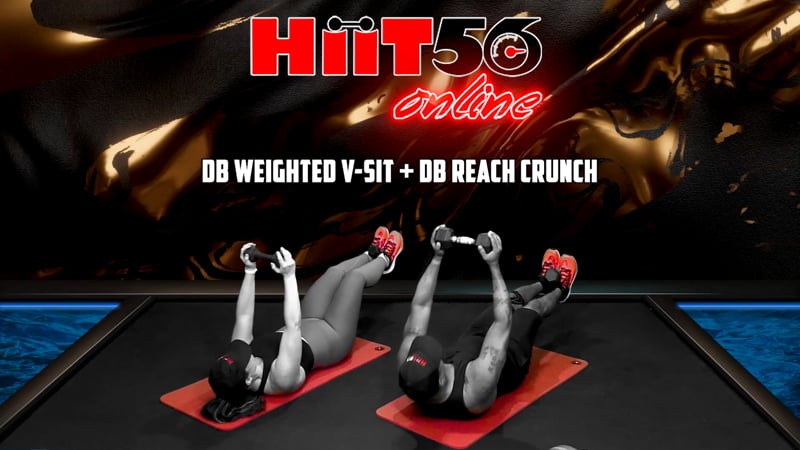DB Weighted V-Sit + DB Reach Crunch
- Duration: 00:00:20
## Dumbbell Weighted V-Sit with Upper Body Crunch
#### Body Part/Parts Used:
- Rectus Abdominis (the "six-pack" muscles)
- Obliques (side abdominal muscles)
- Hip Flexors
- Deltoids (shoulders)
- Serratus Anterior (muscles along your ribs under your pecs)
#### Equipment Needed:
- Two dumbbells of an appropriate weight for your fitness level
#### Difficulty:
- Intermediate to Advanced
#### Directions on How to Perform It:
1. **Starting Position**: Sit on a flat surface with your legs fully extended in front of you. Hold one dumbbell between your feet and another dumbbell horizontally in your hands.
2. **Enter V-Sit**: Engage your core and lift your legs off the ground, holding the first dumbbell securely between your feet. Simultaneously lean your torso back slightly to form a 'V' shape with your body.
3. **Arm Positioning**: Hold the second dumbbell with both hands, arms fully extended straight above your head.
4. **The Crunch**: While maintaining the V-sit and keeping your arms straight, bring the dumbbell in your hands towards the ceiling in a crunching motion. Your shoulders should lift off the ground slightly.
5. **Hold and Lower**: Hold the crunch position for a second or two, engaging your abdominal muscles.
6. **Return**: Slowly lower your arms and torso back to the starting V-sit position.
7. **Repetitions**: Perform the desired number of repetitions based on your workout plan.
#### What It Does and Benefits:
- **Core Strengthening**: This exercise intensely targets the abdominal muscles, making it an excellent choice for building a strong, stable core.
- **Shoulder Engagement**: The overhead crunching motion adds an extra layer of difficulty, engaging your deltoids and serratus anterior, contributing to overall shoulder health and posture.
- **Hip Flexor Activation**: Holding the dumbbell between your feet while maintaining the V-sit engages the hip flexors, helping with hip stability.
- **Calorie Burn**: Given the compound nature of this exercise, you can expect to burn more calories compared to simpler exercises.
#### Body Part/Parts Used:
- Rectus Abdominis (the "six-pack" muscles)
- Obliques (side abdominal muscles)
- Hip Flexors
- Deltoids (shoulders)
- Serratus Anterior (muscles along your ribs under your pecs)
#### Equipment Needed:
- Two dumbbells of an appropriate weight for your fitness level
#### Difficulty:
- Intermediate to Advanced
#### Directions on How to Perform It:
1. **Starting Position**: Sit on a flat surface with your legs fully extended in front of you. Hold one dumbbell between your feet and another dumbbell horizontally in your hands.
2. **Enter V-Sit**: Engage your core and lift your legs off the ground, holding the first dumbbell securely between your feet. Simultaneously lean your torso back slightly to form a 'V' shape with your body.
3. **Arm Positioning**: Hold the second dumbbell with both hands, arms fully extended straight above your head.
4. **The Crunch**: While maintaining the V-sit and keeping your arms straight, bring the dumbbell in your hands towards the ceiling in a crunching motion. Your shoulders should lift off the ground slightly.
5. **Hold and Lower**: Hold the crunch position for a second or two, engaging your abdominal muscles.
6. **Return**: Slowly lower your arms and torso back to the starting V-sit position.
7. **Repetitions**: Perform the desired number of repetitions based on your workout plan.
#### What It Does and Benefits:
- **Core Strengthening**: This exercise intensely targets the abdominal muscles, making it an excellent choice for building a strong, stable core.
- **Shoulder Engagement**: The overhead crunching motion adds an extra layer of difficulty, engaging your deltoids and serratus anterior, contributing to overall shoulder health and posture.
- **Hip Flexor Activation**: Holding the dumbbell between your feet while maintaining the V-sit engages the hip flexors, helping with hip stability.
- **Calorie Burn**: Given the compound nature of this exercise, you can expect to burn more calories compared to simpler exercises.
Categories:
